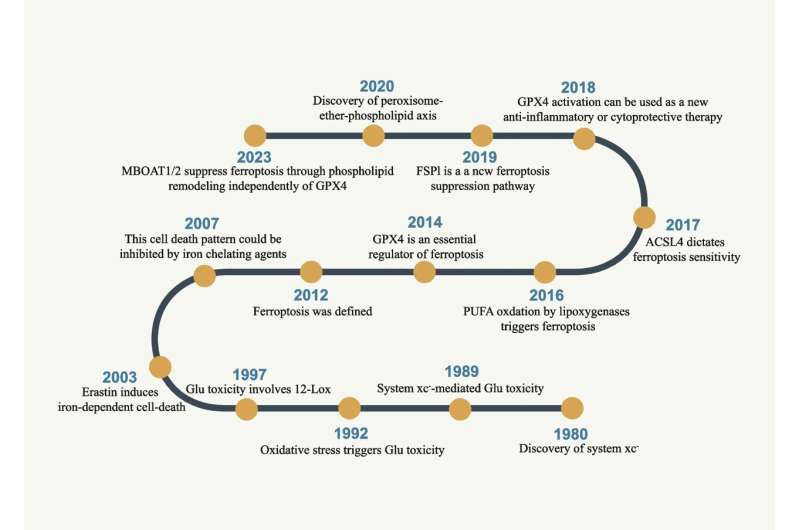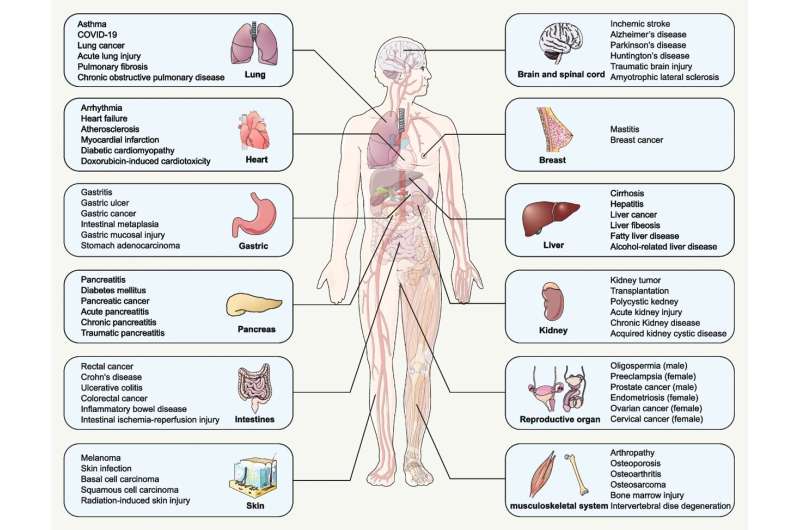This article has been reviewed according to Science X's editorial process and policies. Editors have highlighted the following attributes while ensuring the content's credibility:
fact-checked
proofread
Reviewing the mechanism of ferroptosis and its related diseases

In a review titled "The Mechanism of Ferroptosis and its Related Diseases," Feng and his colleagues from the Department of Urology and the Institute of Urology, State Key Laboratory of Biotherapy, and Cancer Center at West China Hospital, Sichuan University, have undertaken a comprehensive investigation of ferroptosis and its intricate relationships with various diseases.
This review not only discusses the mechanisms of ferroptosis and its associations with diseases but also underscores the pivotal role of compounds in targeting this regulated cell death process for therapeutic applications.
Ferroptosis, initially identified by Dr. Brent R. Stockwell in 2012, gained prominence by demonstrating that iron chelation weakens the effect of Erastin in NRAS-mutant HT-1080 cells. It represents a form of regulated cell death characterized by lipid peroxidation and iron-dependent oxidative stress.
Ferroptosis has garnered attention due to its involvement in a wide spectrum of diseases, including various types of cancers, ischemia/reperfusion injuries, neurodegenerative disorders, and inflammatory conditions. It is characterized by the dependence on iron accumulation, lipid peroxides, and distinct morphological alterations, such as condensed mitochondria and reduced mitochondrial cristae.
The process of ferroptosis is mainly driven by the imbalance between pro-oxidant and antioxidant systems, particularly involving the disruption of iron metabolism. This imbalance leads to the accumulation of iron, triggering the Fenton reaction, which generates harmful reactive oxygen species (ROS). These excess ROS subsequently target and oxidize polyunsaturated fatty acids (PUFAs) in cellular membranes, resulting in lipid peroxidation, cell membrane rupture, and cell death.
In this review, Feng and his colleagues provide an in-depth summarization of the biological processes that regulate ferroptosis, emphasizing the intricate balance between iron metabolism, lipid peroxidation, and antioxidant systems. The researchers dissected the molecular and signaling pathways involved in ferroptosis, offering a comprehensive view of the underlying biological mechanism.

Furthermore, they emphasized a recent report in which Liang et al. identified two phospholipid-modifying enzymes, MBOAT1 and MBOAT2, as novel potent suppressors of ferroptosis through a comprehensive genome-wide screen and molecular investigation. Of note, MBOAT1/2 functions independently of GPX4 and FSP1.
Moreover, the authors claimed that the understanding of the ferroptosis mechanism remained to be further investigated, i.e., the specific process that led to cell death, the initiative, and regulatory mechanisms, and the crosstalk with other types of programmed cell death.
As the importance of ferroptosis emerges, it becomes increasingly evident that targeting ferroptosis is a promising therapeutic strategy for a variety of diseases. Numerous compounds designed to modulate ferroptosis in various diseases have been identified, but a comprehensive summary of these compounds is eagerly awaited.
To address this issue, Feng and his colleagues have updated and summarized relevant compounds targeting ferroptosis, emphasizing their associations with diseases and the mechanisms underpinning them. By summarizing recent progress in this field, the review underscores the potential of these compounds in developing novel treatments across a spectrum of diseases. Inducing or inhibiting ferroptosis using these compounds offers promising prospects for precise medicine.
The authors also noticed that many challenges remain, despite significant progress has been achieved in the field of ferroptosis. These include but are not limited to unraveling the exact regulatory mechanism of ferroptosis, identifying specific biomarkers associated with ferroptosis, and applying compounds targeting ferroptosis in clinics.
In summary, this review offers insights into the mechanisms of ferroptosis and its implications for various diseases, providing a comprehensive and reliable reference source for researchers and students who are interested in ferroptosis. Researchers and clinicians will undoubtedly find that this review is an invaluable resource when they explore the mechanism of ferroptosis and its profound role in human health.
Moreover, it also highlights the translational potential of compounds in modulating ferroptosis, opening doors to innovative therapeutic strategies. The knowledge is instrumental in advancing our understanding of developing targeted therapies where ferroptosis plays a significant role, ultimately improving the life quality of patients.
More information: Shijian Feng et al, The mechanism of ferroptosis and its related diseases, Molecular Biomedicine (2023). DOI: 10.1186/s43556-023-00142-2





















